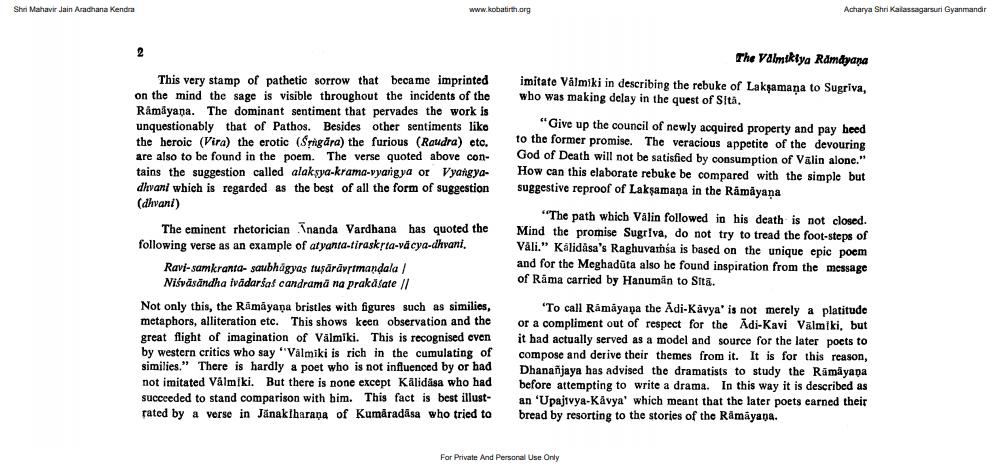Book Title: Valmiki Ramayanam Part 01 Author(s): Amar Publication Publisher: Amar Publication View full book textPage 8
________________ Shn Mahavir Jain Aradhana Kendra www.kobaith.org Acharya Shri Kalassagarsun Gyanmandir The Valmıkiya Ramdyana imitate Valmiki in describing the rebuke of Lakpamaņa to Sugriva, who was making delay in the quest of Sita, This very stamp of pathetic sorrow that became imprinted on the mind the sage is visible throughout the incidents of the Ramayana. The dominant sentiment that pervades the work is unquestionably that of Pathos. Besides other sentiments like the heroic (Vira) the erotic (Spigara) the furious (Raudra) etc. are also to be found in the poem. The verse quoted above contains the suggestion called alaksya-krama-varigya or Vyangya. dhvani which is regarded as the best of all the form of suggestion (dhvani) The eminent rhetorician nanda Vardhana has quoted the following verse as an example of atyanta-tiraskrta-vdcya-dhwani. "Give up the council of newly acquired property and pay heed to the former promise. The veracious appetite of the devouring God of Death will not be satisfied by consumption of Välin alone." How can this elaborate rebuke be compared with the simple but suggestive reproof of Laksamana in the Ramayana "The path which Vålin followed in his death is not closed. Mind the promise Sugriva, do not try to tread the foot-steps of Vali." Kalidasa's Raghuvamsa is based on the unique epic poem and for the Meghaduta also be found inspiration from the message of Rama carried by Hanuman to Sita. Ravi-samkranta- saubhagyas fusārāvrtmandala / Niśvasandha ivadarśaf candrama na prakásafell Not only this, the Ramayana bristles with figures such as similies, metaphors, alliteration etc. This shows keen observation and the great flight of imagination of Valmiki. This is recognised even by western critics who say "Valmiki is rich in the cumulating of similies." There is hardly a poet who is not influenced by or had not imitated Valmiki. But there is none except Kilidia who had succeeded to stand comparison with him. This fact is best illustrated by a verse in Janaklharana of Kumaradása who tried to "To call Ramayana the Adi-Kavya' is not merely a platitude or a compliment out of respect for the Adi-Kavi Vālmiki, but it had actually served as a model and source for the later poets to compose and derive their themes from it. It is for this reason, Dhananjaya has advised the dramatists to study the Rāmāyapa before attempting to write a drama. In this way it is described as an 'Upajvya-Kavya' which meant that the later poets earned their bread by resorting to the stories of the Ramayana. For Private And Personal Use OnlyPage Navigation
1 ... 6 7 8 9 10 11 12 13 14 15 16 17 18 19 20 21 22 23 24 25 26 27 28 29 30 31 32 33 34 35 36 37 38 39 40 41 42 43 44 45 46 47 48 49 50 51 52 53 54 55 56 57 58 59 60 61 62 63 64 65 66 67 68 69 70 71 72 73 74 75 76 77 78 79 80 81 82 ... 468
